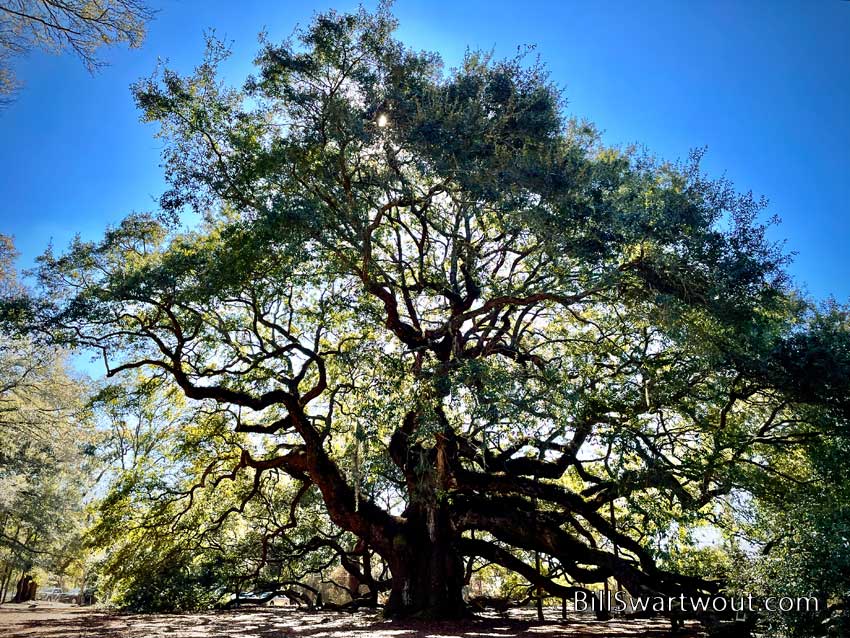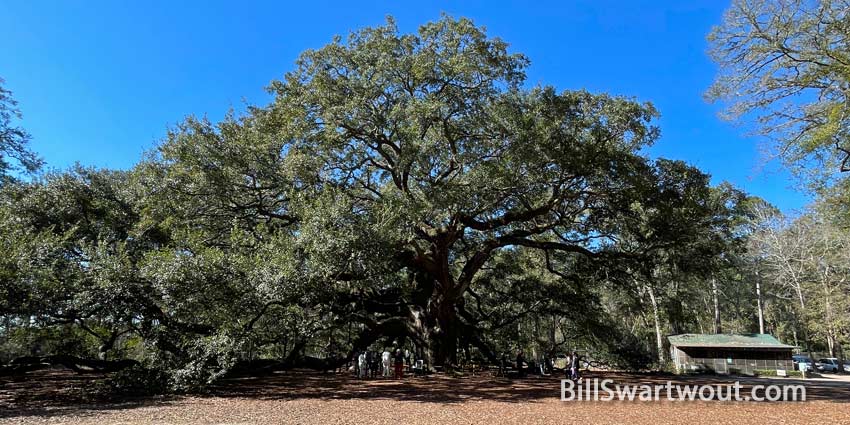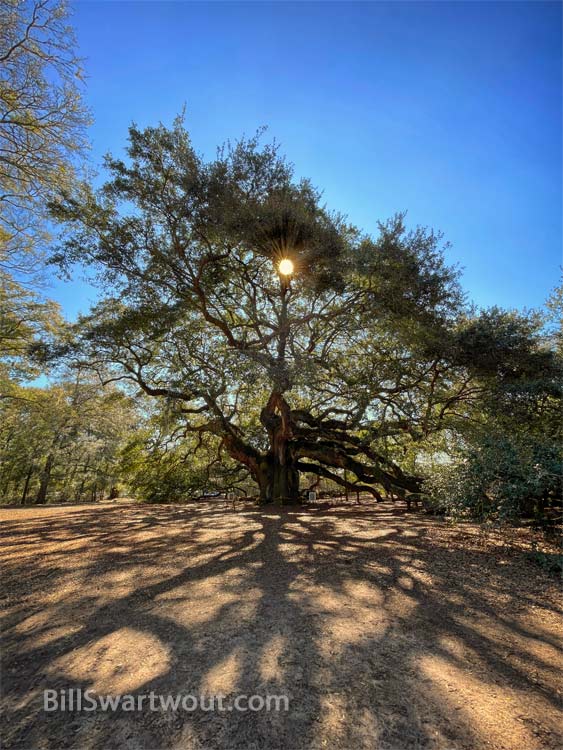This iconic tree is located on St. John’s Island just south of Charleston, SC
Tucked away in the heart of South Carolina’s picturesque Lowcountry, stands the ancient and awe-inspiring Angel Oak Tree. With its sprawling branches, some reaching up to 65 feet, and a canopy that spans over 17,000 square feet, this natural wonder is believed to be over 400 years old. The tree’s enduring presence evokes a sense of serenity and timelessness, inviting visitors to experience an unparalleled connection with nature.

As one gazes upon the Angel Oak Tree, it becomes evident that this magnificent specimen has stood witness to centuries of history and change. Its gnarled limbs seem to tell stories of resilience and growth, offering a tangible link to the past while inspiring contemplation about the future. Surrounded by lush greenery and resonant with tranquility, this sacred site serves as a poignant reminder of nature’s enduring beauty and significance in our lives. Whether you are a nature enthusiast or simply seeking solace in the midst of modern chaos, the Angel Oak Tree promises an unforgettable encounter that transcends time and captures the essence of South Carolina’s natural splendor.
History of Angel Oak Tree
The Angel Oak is a majestic natural wonder with a rich and intriguing history. Believed to be around 400-500 years old, this sprawling live oak has stood witness to centuries of events and changes in the surrounding environment. Named after the estate of Justus Angel, who once owned the land where it grows, the tree has become an iconic symbol of resilience and endurance.
Visitors are often struck by the awe-inspiring presence of the Angel Oak Tree, its massive limbs stretching out like ancient guardians embracing all who come near. The significance of this living monument goes beyond its physical beauty; it serves as a reminder of our deep connection to nature and our shared history. From Native American legends to European settlers’ tales, the tree embodies a tapestry of cultural narratives that have shaped the region over time. Whether you’re drawn to its soothing shade or its remarkable survival against natural disasters and development pressures, there’s something undeniably captivating about the Angel Oak Tree’s enduring legacy.
Characteristics and significance
The Angel Oak Tree, located near Charleston, SC, stands as a testament to the enduring characteristics of strength and resilience. Its massive limbs stretch outwards, offering shade and sanctuary for countless visitors who come to marvel at its magnificence. The tree’s longevity, estimated at over 400 years old, serves as a powerful symbol of timelessness and endurance in the face of adversity.
Moreover, the significance of the Angel Oak Tree extends beyond its physical presence; it embodies a deep connection to history and nature. As one stands in awe beneath its sprawling branches, there is a profound sense of reverence for the interconnectedness of all life on earth. The tree evokes a feeling of humility and respect for the natural world, reminding us of our place within it and inspiring an appreciation for the beauty and wisdom that can be found in even the oldest living organisms.
Visitors and tourism
Visitors and tourism play a vital role in the preservation and promotion of natural wonders like the Angel Oak Tree near Charleston, South Carolina. The influx of tourists not only brings economic benefits to the local community but also raises awareness about the significance of protecting these natural treasures. Moreover, visitors have the opportunity to learn about the history and cultural importance of the Angel Oak Tree, fostering a deeper appreciation for nature.
Tourism also creates an opportunity for cultural exchange and understanding as people from various backgrounds come together to experience this remarkable attraction. Additionally, by attracting attention from around the world, tourism can encourage greater investment in conservation efforts to safeguard such iconic landmarks for future generations. Overall, visitors can contribute positively to the sustainability and protection of places like the Angel Oak Tree through their engagement with responsible tourism practices and support for environmental initiatives.
Conservation efforts
Conservation efforts around the world are crucial for preserving natural wonders like the Angel Oak. With 400,000+ visitors every year, the sustained popularity of this iconic tree has led to increased foot traffic and potential damage to its delicate ecosystem. In response, conservationists have implemented measures to protect the Angel Oak Tree, such as controlled visitation hours, ample signage, and educational programs to promote responsible tourism.
Moreover, collaborative partnerships between local communities and environmental organizations have further bolstered these efforts. By engaging with residents and visitors alike, these initiatives seek to foster a deeper appreciation for nature while emphasizing the importance of sustainable practices. Overall, championing conservation efforts not only safeguards treasured landmarks but also cultivates a legacy of environmental stewardship for future generations to embrace and uphold.
Local legends and myths
Local legends and myths have long been associated with the Angel Oak Tree. One of the most popular legends is that the tree is named after an 18th-century ghost known as the Angel of Bethesda, who supposedly haunts its branches. Some locals also believe that the tree is inhabited by protective spirits that watch over all who visit it. These stories have contributed to the mystical aura surrounding the Angel Oak, adding a layer of intrigue to its already impressive presence.
In addition to these supernatural tales, there are also local myths about the origin and age of the tree. While scientists estimate its age to be around 400-500 years old, many legends claim it to be much older, attributing its existence to divine or mythical origins. These myths serve not only as folklore but also as a testament to the deep reverence and awe inspired by this magnificent natural wonder in South Carolina.
Preserving this natural wonder
In conclusion, the preservation of the Angel Oak in the South Carolina Low Country is not just a matter of environmental conservation but also a testament to our appreciation for natural wonders. This majestic oak stands as a symbol of resilience and endurance in the face of urbanization and climate change. Preserving this natural wonder not only ensures the survival of a unique species but also provides an opportunity for future generations to connect with nature in its purest form.

Furthermore, by protecting the Angel Oak Tree, we uphold our commitment to biodiversity and ecological balance. The tree provides habitat for various organisms, contributes to air quality, and adds irreplaceable beauty to the landscape. Its preservation also serves as a reminder that small acts can make a big difference – from supporting local conservation efforts to advocating for sustainable development practices. In essence, preserving this natural wonder is an investment in both the present and future well-being of our planet and all its inhabitants.
Visit Angel Oak Park
Location: 3688 Angel Oak Rd, Johns Island, SC 29455
Links to see more wall art
Browse and/or purchase by clicking a link below.
Link: Angel Oak Sunny Glow
Link: Angel Oak Tree Casting Shadows









